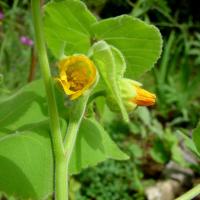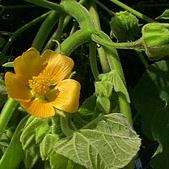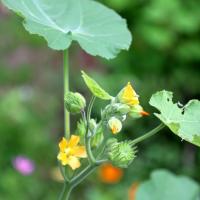Butterprint
Abutilon Theophrasti
It grows to 2 m tall, and has velvet-like heart-shaped leaves 15–25 cm broad. Theflowers are yellow or orange, 4 cm diameter, maturing into button-shaped capsules which split lengthwise to release the seeds. The flowers and plants have a fruity scent.
Velvetleaf grows as a weed primarily in cropland, especially corn fields, and it can also be found on roadsides and in gardens. Velvetleaf prefers rich and cultivated soils, such as those used in agriculture.
Cultivation and uses
Velvetleaf has been grown in China since around 2000 BCE for its strong, jute-likefibre. The leaves are edible, stir-fried or in omelette. The plant is known as maabulhain the Maldives and its leaves were part of the traditional Maldivian cuisine, usually finely chopped and mixed with Maldive fish and grated coconut in a dish known asmas huni. The seeds are eaten in China and Kashmir.
Invasive species
In midwestern and northeastern regions of the United States, eastern Canada and theEastern Mediterranean, A. theophrasti is considered a damaging weed to agricultural crops, especially corn and soybeans.
Since being introduced to North America in the 18th century, velvetleaf has become aninvasive species in agricultural regions of the eastern and midwestern United States. It is one of the most detrimental weeds to corn causing decreases of up to 34% of crop yield if not controlled and costing hundreds of millions of dollars per year in control and damage. Velvetleaf is an extremely competitive plant, so much so that it can steal nutrients and water from crops.[8] Velvetleaf is controllable by herbicides.

















Plant Protection Products
- N/A
- ⭑⭑
- N/A
- N/A
- N/A
- N/A
- N/A
- N/A
- N/A
- N/A